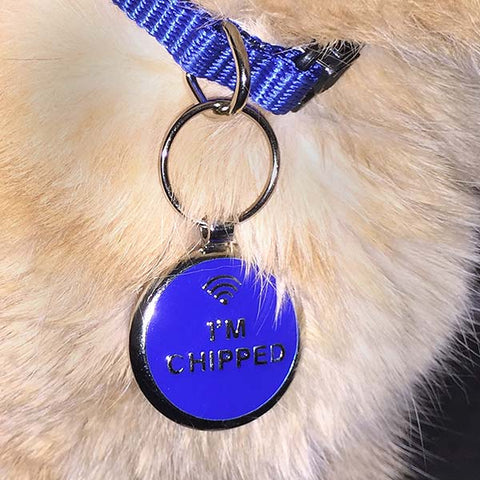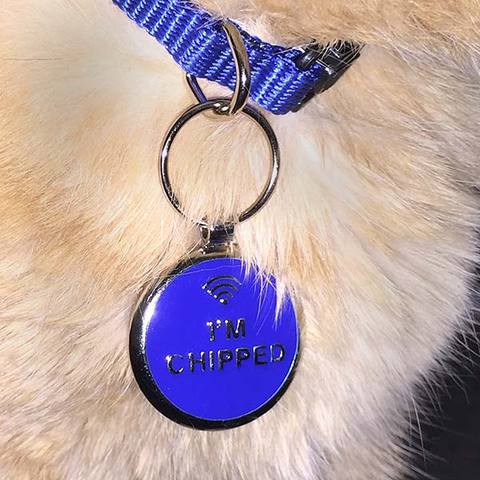
We sell pet ID tags. For that reason, you may think that we're about to bash microchips, but we're not. They're safe and (can be) amazingly effective. Your pet should absolutely be microchipped. That said, ALL pet experts agree that even microchipped pets should wear pet ID tags as well. Each ID method has its strengths and weaknesses. Pet tags are so simple everyone knows how they work. On the other hand, microchip identification is often misunderstood and requires multiple steps to be successful for the system to work.
Many people don't know or have never even considered how a microchip might get their pet back home. Some mistakenly think that a microchip uses GPS to track and find a lost pet. Others may think that the paperwork they filled out at the adoption automatically registered the chip. But most people probably haven't thought about it all. And that is the biggest problem with pet microchips: out of sight, out of mind. That is until you need it to work.
How Microchips (are supposed to) Work

We've all heard the incredible stories of pets that were lost for years and found thousands of miles from home. In those stories, a shelter worker scans the lost pet and finds a microchip. That leads to the phone call to the stunned pet owner. And finally, the requisite Facebook video of the happy reunion. This is what happens when a microchip works as it was designed. And this is what everyone expects.
But finding a lost pet's owner with a microchip doesn't always happen this way. In fact, some studies suggest that it works this way less than half the time. The problems are rarely with the microchip itself. While it is possible that a chip can migrate and be missed or even stop working altogether, those are seldom the cause of microchips not "working."
One potential obstacle is the scanner itself. Years ago, this was a huge problem; competing microchip companies sold a scanner that could only read their own brand of microchips. If your pet had a different brand of chip, it may as well not have one at all. Today's universal scanners are able to read any brand of microchip. At your pet's next vet visit, ask to have your pet scanned. If it works, the scanner will display a 9, 10 or 15 digit number (some have letters as well). You're over the first hurdle, the chip is in place and communicating. You should know the chip number for all your pets and have them written down somewhere in your files.
087020800 = ?

If your lost pet is found and scanned, the finder now has the microchip number. This number is the only link between you and your pet and yet, it means absolutely nothing. So how can that number lead to a phone call to you? This step requires a computer, the internet, massive databases, and most importantly, someone who knows how to make it all come together. When it all works, your pet's microchip number will lead to a database listing with your contact information.
The Most Common Reason Microchips Fail
Each microchip company maintains their own database of numbers. The first few numbers may identify which company made the chip (but not always). And usually, a chip number is only registered in one database (but again, not always). The person doing the scanning would first decode the first 3 numbers to determine which company's database to check. As more and more companies got into the microchipping business, the procedures for finding the correct database became very confusing and fraught with potential errors. Recognizing this as a tremendous problem several years ago, the non-profit American Animal Hospital Association (AAHA) launched a website that offered one place to punch in any chip number. It is, in effect, a database to keep track of all the other databases. The database on this site does not contain the microchip file with your contact information, but in a few seconds, the site will tell you when the chip was registered and with what company.
Testing The System
Try the AAHA site with your pet's microchip number:
http://www.petmicrochiplookup.org/
The site should tell you the name and number of the microchip company that made your pets chip. Contact the company listed and ask them for the contact information that is listed for your pet's microchip number. Hopefully, all the contact information will be correct. What you've just done is the exact procedure that anyone trying to help your lost pet will likely do. When we tried it recently, we found that our information was wrong despite having called our registry company and updating our information. If you discover errors in yours as well, at least now you know, and you can follow whatever procedure the company requires to make it all correct.
So Why Is Contact Information So Often Wrong?

When your pet got his or her microchip, the number was recorded and put in their file. If it was at a shelter, likely the shelter's contact information was registered to the chip number. At the adoption, the proud new parents were probably told to make sure and contact the microchip company, pay a fee and change the contact information from the shelter to their own, the pet's new home. But there's a lot of paperwork and the excitement of a new family member. Maybe no one ever got around to updating the chip register. This happens often and makes it much more difficult to find the pet's current owner.
Or maybe your pet already had a chip when you adopted him. Do you have any idea if the microchip is registered at all? And to whom? And suppose you did everything correctly years ago, is your recorded information all still current?
It all boils down to this: If your pet was lost right now and someone checked the microchip information, would they find you? The chip is doing its job, waiting, ready to report its number to anyone that asks. Making sure that number leads back to you is your responsibility.
Protect Your Pet By Doing This Now
If you've ever lost a pet, you know the feeling: wishing you'd done more to ensure his quick and easy return home. These few simple tasks below will make all the difference in the world for getting your pet back home safely. Once your pet is lost, you won't be able to do this so do it now.-Make sure your pet wears a pet ID tag. Check it periodically to make sure it's readable and correct.
-Make sure your pet's microchip is scannable and working (next vet visit).
-Know the microchip number and most importantly, use the site above to make sure the information they'll find is up to date.
None of this is difficult, but it is a bit of work. You'll feel better after you do it and if your pet ever gets lost, you'll know that the microchip ID system is ready to help get your pet back home.

